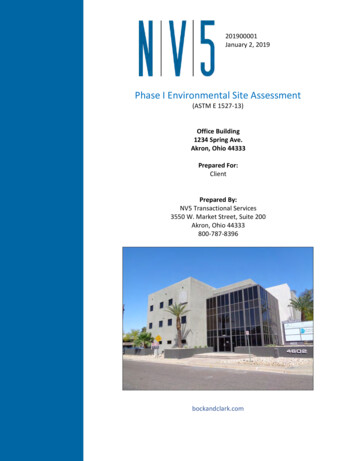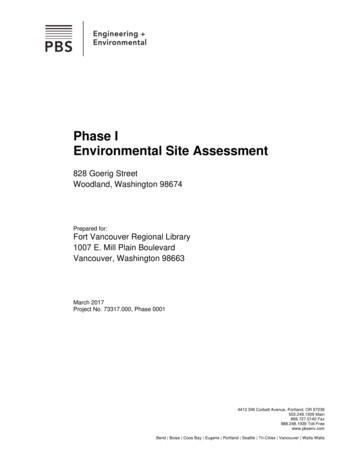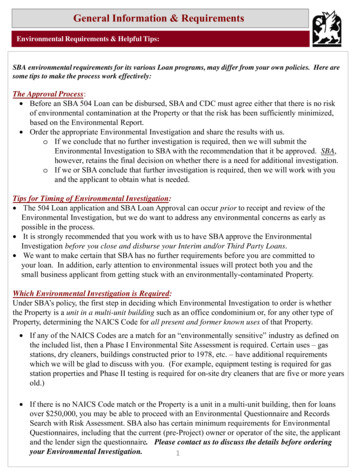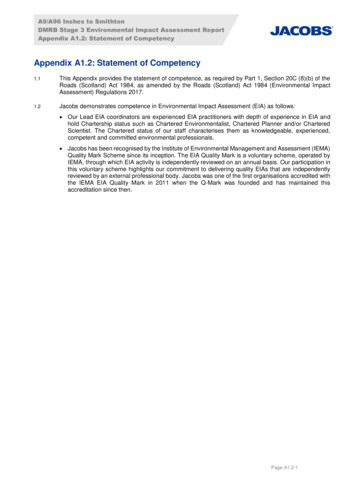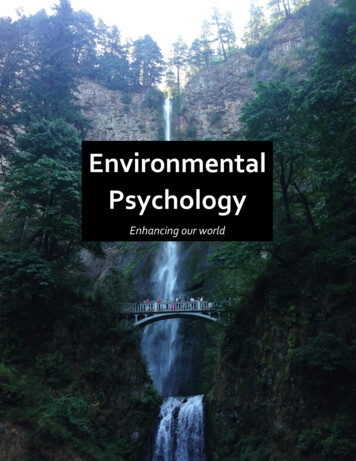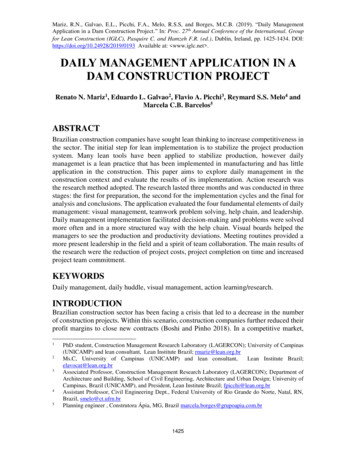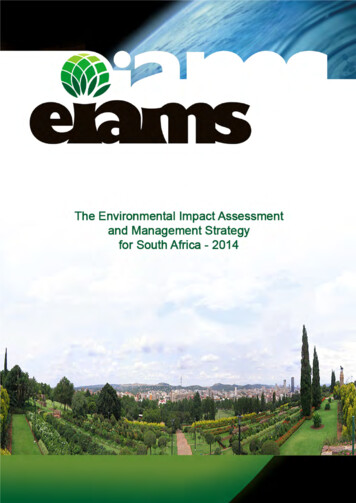
Transcription
Suggested citation:Department of Environmental Affairs, 2014, Environmental Impact Assessment and Management Strategy for SouthAfrica (Draft).The analysis and recommendations of this Report do not necessarily reflect the views of the Department ofEnvironmental Affairs. The recommendations do not necessarily carry the full support of all the sectors represented.Errors or omissions found subsequent to printing will be corrected in the online version at www.environment.gov.zaLogo design by Kotie Geldenhuys.Cover photograph provided by City of Tshwane. Photographer unknown.Photographed from the Union Buildings towards the city.Project Steering Committee:Department of Environmental Affairs, the Department of Water Affairs, Provincial Competent Authorities and LocalAuthorities; Non-Governmental Organisations; Environmental Law Association; Chamber of Mines; Business UnitySouth Africa (BUSA); the South African Local Government Association (SALGA); the Academic sector and the SouthAfrican affiliate of the International Association for Impact Assessment.Project Coordinator: Madeleine OosthuizenThe Project Steering Committee is established by the Department of Environmental Affairs (DEA) for identified sectors tocollaborate on a strategy for impact assessment and management in South Africa.1
AcknowledgementsAcknowledgement to the EIAMS Project Steering Committee members who devoted their time, skills and energy on acontinuous basis over the past 4 years. The contributions of many other individuals from the various sectors, whosecomments were reported to the PSC by their sector representatives, are gratefully acknowledged.Angela AndrewsNGO Legal Resources Centre (LRC) (Theme 1 Coordinator)Amanda BritzNational Department of Environmental AffairsJanet BodensteinCity of Cape Town:ERMDesmond D’SaNGO SDCEACarol DixonBUSAChantal EngelbrechtNational Department of Environmental AffairsDee FisherNational Department of Environmental AffairsChris GalliersNGO WESSA (Theme 1 Coordinator)Paul HardcastleWC Department of Environmental Affairs and Development Planning (Theme 1 Coordinator)Richard HillAcademic Sector (Theme 1 Coordinator)Sibusisiwe HlelaNational Department of Environmental AffairsMercia KomenNGO SectorMatome MakwelaChamber of MinesBetty MdalaNational Department of Environmental AffairsAdele MeyerBusiness South Africa (BUSA)William MNgomaKZN Department of Agriculture and Environmental AffairsSimon MoganetsiNational Department of Environmental AffairsVictor MongweLimpopo Department of Economic Development, Environment and TourismStephinah MudauChamber of MinesDashentha NaidooDepartment of Water AffairsSean O’ BeirneEAP (SES) (Chairperson: Conflict Resolution Committee and pro-bono facilitator)Madeleine OosthuizenDEA: Project Coordinator and ChairpersonKoos PretoriusNGO Federation of Sustainable Environment (FSE) (Theme 2 Coordinator)Dhiraj RamaAssociation of Cementitious Material Producers (ACMP)Francois RetiefIAIAsa (Theme 1 Coordinator)John ScotcherBUSARichard SummersEnvironmental Law Association (ELA) (Theme 1 Coordinator and pro-bono facilitator)Chumisa ThengwaeThekwini MunicipalityGerrie van SchalkwykIAIAsa (Theme 2 Coordinator)The report is the product of the collaboration involving the members Project Steering Committee, the sectors theyrepresent and input from the Advisory and Reference Groups. Numerous individuals, colleagues and professionalsprovided information and expert opinion, and are acknowledged for their contribution. In particular –Jenny Hall- Enviro Council , SAGerard van Weele- South AfricaJohan Nel- North West University, SASusie Brownlie- Cape TownJenny Pope- AustraliaMary-Jane Morris- Cape TownPeter Croal- CanadaIngrid Coetzee- Cape TownAngus Morrison-Saunders- AustraliaCharl de Villiers- Botanical Society of SA2
Special mention is made of the small task team for considering comments, relevant amendments to report and finalediting of draft strategy. These volunteers generously gave their time over and above their active contribution on theSteering Committee.Paul HardcastleRichard Hill – final editorMercia KomenSean O’ BeirneFrancois RetiefRichard SummersThe team included Madeleine Oosthuizen, Project Coordinator and author of the first draft “Environmental ImpactAssessment and Management Strategy”.Appreciation goes to the authors of the eleven Sub-Theme Reports –EnAct International: Ingrid Coetzee, Glendyr NelDEA: Madeleine OosthuizenMLA-Sustainability Matters: Marlene LarosNGO Sector: Mercia KomenPhelamanga Projects: Rod BulmanSE Solutions (Pty) Ltd: Sean O’BeirneSSI Environmental: Mark Freeman, Janet Loubser, Gillian Maree, Malcolm Roods, Gerard van WeeleThe Green Connection: Christy Bragg, Basier Dramat, Liz Mcdaid, Lynette Munro, Roshan StanfordAnd Theme Reports –Council for Scientific and Industrial Research (CSIR):Benita de Wet, Michelle Audouin, Douglas Trotter, Marius Claassen, Karen NortjeuKhozi Environmentalists:Ken Smith, Marita Oosthuizen, Jaco Grundling, Elbie Oosthuizen3
Definition of TermsAdaptive managementAdaptive management strives to eliminate, reduce or rectify unforeseen or adverseimpacts through corrective action. It responds to evidence of impacts and continuallymonitors and assesses the efficacy of changes in management action, which achievesbest practice and continual improvement.AlignmentThe proper positioning of parts in relation to each otherAccessibleAble to be easily obtained or used; easily understood or appreciated. Also meansremoving the barriers that prevents access to websites and electronic documentation bypeople with disabilities.Biodiversity offsetsConservation activities that are designed to give biodiversity benefits to compensate forlosses. These 'averted loss offsets' aim to reduce or stop biodiversity loss (e.g. futurehabitat degradation) in areas where this is predicted. The offset should result in theprotection of equal or more environmental assets, measured in size, type and function.This form of ecological compensation is sustained over time.Building PlatformBuilding Platforms are the main objectives of the Environmental Impact Assessment andManagement Strategy, and are expressed as desired outcomes.Capacity BuildingBuilding abilities, relationships and values that will enable organisations, institutions andindividuals to improve their performance and achieve sustainability. It includes influencingcollective and individual beliefs, values and practices to alter behaviour and performance.Civil SocietyCivil society is the sphere of organizations and/or associations of organizationslocated between the family, the state, the government of the day, and the prevailingeconomic system, in which people with common interests associate voluntarily. Amongstthose organizations, they may have common, competing or conflicting values andinterests.Source: National Development Agency (www.nda.org.za)ConstitutionThe Constitution of South AfricaCoordinationThe organization of different elements of a complex body or activity to enable them towork together effectively.Corporate governanceRefers broadly to the rules, processes, or laws by which businesses are operated,regulated, and controlled.Credible spatialplanning frameworksSDFs that are informed by an SEA or EMF that was compiled during the SDF planningprocessCorporate SocialInvestment (CSI)Corporate Social Investment encompasses projects that are external to the normalbusiness activities of a company and not directly for purposes of increasing companyprofit. These projects have a strong developmental approach and utilise companyresources (time, money and/or expertise) to benefit and uplift communities and are notprimarily driven as marketing initiatives.4
Desired State of theEnvironment ReportsThe main purpose of this category of reporting is to determine a desired state for theenvironment and to contrast this with the current (status quo) state of the environment.These may include reporting by using environmental management tools and instrumentssuch as environmental outlook reporting, sustainability-led SEAs, EMF’s or other spatialtools.DiscretionRefers to a careful, cautious, good judgement in decision-making which is guided byclear parameters and defined able development implies the selection and implementation of a developmentoption which allows for appropriate and justifiable social and economic goals to beachieved without compromising the natural system on which it is based. Sustainabledevelopment therefore ensures that non-negotiable environmental thresholds aremaintained, ecosystems are sustained, effective climate change mitigation and adaptionis facilitated, and natural resources are used effectively. A movement to a green and lowcarbon economy is required.Fit for purposeThe Environmental Management instrument or tool is appropriate to the nature, scale andscope of a proposal or activity and the level of assessment required to enable defensible,informed and impartial environmental decision making; the instrument or tool isappropriate to the significance of anticipated impacts, providing for a scoped yetcomprehensive analysis to enable the identification, prediction, assessment andevaluation of the potential and actual environmental impacts and the risks of proposalsand activities; and will enable the consideration of alternatives and options for mitigation,with a view to minimising negative impacts, maximising benefits and promotingcompliance with the national environmental management principles in section 2 ofNEMA.Information andmanagement systemsInformation Systems record and store information. Information management systems area sub-set of information systems, and provide information in a format which collates,compares, categorises or otherwise makes information more valuable.EnvironmentalManagementThe management process to achieve the philosophy of Integrated EnvironmentalManagement.Environmental OutlookReportThe Environmental Outlook Report goes beyond traditional State of the EnvironmentReports in that it build on the analysis of past and current trends to outline policy optionsfor the future, leading to different outcomes over the next 20–30 years. This report shouldinclude quantitative indicators or indices of sustainable development and nersDelineated to include those in the private and NGO sectors, academics, and officials in allspheres of government and includes all the proposed classifications of the environmentalprofession namely EAP, Public Participation Practitioner, ECO, SIA practitioner,practitioners specialising in using Environmental Spatial Planning and Strategic Planningtools.GuidelinesGuidelines serve to streamline processes according to sound practice, advising onmatters related to processes, regulations and legislation of IEM and the selection ofappropriate selection and use of instruments and tools. In this Strategy ‘guidelines’include manuals, regulatory guides, guidelines and information series documents.5
Impact mitigationhierarchyThe Impact Mitigation Hierarchy is a tool which is used reiteratively throughout a projectlifecycle to limit negative impacts on the environment. The first tier considers how toavoid the impact entirely and is considered early in the project to allow for alternatives tobe considered. The impacts which cannot be avoided should be minimised. Effectiveminimisation can eliminate some impacts and reduce others allowing for sustainabilitytargets to be met. Where the targets cannot be met, the application should be declined.The next consideration is restoration and takes place where minimisation efforts havefailed to reach the required target. Finally, and as a last resort to compensate forecological loss or residual impacts, the environmental loss or damage can be offsetthrough compensation. The intention of this level is to ensure the protection of equivalentor greater ecological assets than those lost, or to rehabilitate a degraded environmentrestoring equivalent ecological assets.IndicatorsSomething observed or calculated that is used to show the presence or state of acondition or trend.InstrumentA means by which something is effected or done; sometimes an established process bywhich something takes place or is brought about. Examples in the context of IEM include:EMFs, EIPs, conservation and bioregional plans, and environmental management plans.IntegratedEnvironmentalManagement (IEM)A philosophy which prescribes a code of practice for ensuring that environmentalconsiderations are fully integrated into all stages of the development and decision-makingprocess. The IEM philosophy (and principles) is interpreted as applying throughout typicalmanagement activities of plan, do, act and check of any proposal (project, plan,programme or policy) or activity - at the local, national and international level - that has apotentially significant effect on the environment. Implementation of this philosophy relieson the selection and application of appropriate tools to a particular proposal or activity.The practice of IEM persists throughout the lifecycle of the project, plan or policy. Seealso Environmental Management (EM)IntegrationCombine two or more things to form a whole.Interested and AffectedParties (I&APs)Individuals, communities or groups, other than the proponent or the authorities, whoseinterests may be positively or negatively affected by a proposal or activity and/or who areconcerned with a proposal or activity and its consequences. These may include localcommunities, landowners, residents, investors, business associations, trade unions,customers, consumers and environmental interest groups. The principle thatenvironmental consultants and stakeholder engagement practitioners should beindependent and unbiased excludes these groups from being considered I&APs.LevelDescriptive of the relative point on a scale, generally implying some ranking. Here alsoused to indicate organisational scale such as spheres of government.Life cycle assessmentA process where the potential environmental effects or impacts of a product or servicethroughout the life of that product or service is evaluated.Limits of acceptablechangeNon-negotiable ecological thresholds required to maintain natural capital over time.Non-governmentalorganisations (NGOs)Voluntary environmental, social, labour or community organisations, charities or pressuregroups.6
ObjectivesSomething that one's efforts or actions are intended to attain or accomplish; refers topurpose, goals and targets. In the strategy “objectives” are used referring to widerobjectives while “targets” are used when more detailed information is available to setmore specific detailed targets based on identified indicators. The strategy proposes aprogression from objectives to indicators, and indicators to detailed targets as moredetailed information becomes available.Peer reviewThe evaluation of work by one or more people of similar or better competence to theproducers of the work. Peer review is regarded as a form of self-regulation to maintainquality standards, improve performance and provide credibility.PillarIn the Environmental Impact Assessment and Management Strategy the pillarssummarise the shared direction or intent which support attaining the objectives, calledBuilding Platforms. Actions and Goals are to be defined within each Pillar, and theimplementation will lead to the attainment of each objective, and therefore of the Vision.The progression of environmental instruments, tools and plans describes the differenttypes of instruments and tools and plans, from broad to specific that are used in the IEMprocess. A robust flow of information between the instruments and tools should takeplace. Strategic planning should influence project specific assessment and decisions andproject specific information should inform strategic planning. Each instrument or toolprovides specific information which, in combination with that provided by the others,broadens understanding of environmental opportunities and constraints for sustainabledevelopment, and improves decisions and implementation.Progression of toolsProponentAny individual, government department, authority, industry or association proposing anactivity (e.g. project, programme or policy).Role-playersOne who assumes or acts out a particular role. Used to inclusively comprise all persons,groups and organisations who are involved in directing, leading or actively contributing tothe processes of environmental planning and management, in order to influence theprocesses and their outcomes.ScaleA measure of something relative to another thing.ScopeIndicates boundaries, reach, limits in time, space, capacity or opportunity.SectoralSectors are all units of central, provincial and local government, which includesmunicipalities and district municipalities. Also a collection of shared interests andcharacteristics unique to the sector but shared within. Examples are mining, energy,health.StakeholderA sub-group of the public whose interests may be positively or negatively affected by aproposal or activity and/or who are concerned with a proposal or activity and itsconsequences. The term therefore includes the proponent, authorities (both the leadauthority and other authorities) and all interested and affected parties (I&APs). Theprinciple that environmental consultants and stakeholder engagement practitionersshould be independent and unbiased excludes these groups from being consideredstakeholders (Source: DEA Information Series).See also: Interested and Affected Parties7
StrategicEnvironmental ForumsFunction of these forums is to coordinate the formulation of strategic environmentalplans, including the monitoring of the implementation of EIPs and EMPs againstsustainability targets, EMFs, SEAs, the application of spatial instruments and other crosssectoral planning initiatives, the alignment and integration of regulatory procedures (i.e.application processes and information requirements) and where appropriate, thealignment and/or integration of decision making in regulatory processes. of policies, plansand programmes (especially SEAs, EMFs and SDFs), based on the achievement ofdetermined sustainability objectives and targets, as well as the requirements contained inprovincial EIPs.Facilitate the coordination and alignment of policies, plans and programmes (especiallySEAs, EMFs and SDFs), based on the achievement of determined sustainabilityobjectives and targets, as well as the requirements contained in provincial EIPs.SustainabilitySustainability in this context implies ecological sustainability. In the first instance, itrecognises that the maintenance of healthy ecosystems and natural resources arepreconditions for human wellbeing. In the second instance, it recognises that there arelimits to the goods and services that can be provided. In other words, ecologicalsustainability acknowledges that human beings are part of nature and not a separateentity. See also ecologically sustainable elopmentThe key mechanism for measuring performance in terms of achieving sustainability.TokenismThe practice of making only a symbolic effort.ToolA tool is a thing for working on something; a device or implement used to carry out aparticular function, a means to an end. Examples in IEM include: Life Cycle Assessment,Cost benefit analysis, Environmental Auditing,Trade-offsThe transformation of one form of capital to another. The exchange of one thing foranother of more or less equal value, especially to effect a compromise. Often a trade-offis the transformation of one form of capital to another; a balancing of factors all of whichare not attainable at the same time.The maintenance of healthy ecosystems and natural resources are preconditions forhuman wellbeing and there are limits to the goods and services that can be provided.Ecological sustainability recognises that human beings are part of nature and not aseparate entity. There are non-negotiable ecological thresholds that need to bemaintained. The social and economic sub-systems are embedded within the ecosystem.8
Acronyms and AbbreviationsACMPAssociation of Cementitious Material ProducersAMDAcid Mine DrainageBABasic AssessmentBUSABusiness Unity South AfricaCHECouncil on Higher EducationCO2Carbon dioxideCPDContinuing Professional DevelopmentCSIRCouncil for Scientific and Industrial ResearchDBSADevelopment Bank of Southern AfricaDEADepartment of Environmental AffairsDEA GISDepartment of Environmental Affairs' Geographic Information SystemsDMRDepartment of Mineral ResourcesDWADepartment of Water AffairsEAEnvironmental AssessmentECOEnvironmental Control Officer (also Waste Management- , Emission- and Fishery Control Officer)EIAMSEnvironmental Impact Assessment and Management StrategyEIPEnvironmental Implementation PlanEMEnvironmental ManagementEMFEnvironmental Management FrameworkEMPEnvironmental Management PlanEMPrEnvironmental Management ProgrammeEMSEnvironmental Management SystemFSEFederation for a Sustainable EnvironmentGISGeographic Information SystemHEQCHigher Education Quality Committee9
IAIASASouth African affiliate of the International Association for Impact AssessmentLCALife Cycle AssessmentLRCLegal Resources CentreMSAMunicipal Systems ActMTSFMedium Term Strategic FrameworkNDPNational Development PlanNEASNational Environmental Authorisation System (administrative tracking system)NEM:AQANational Environmental Management: Air Quality Act (39 of 2004)NEM:BANational Environmental Management: Biodiversity Act (10 of 2004)NEM:ICMNational Environmental Management: Integrated Coastal Management Act (24 of 2008)NEM:PAANational Environmental Management: Protected Areas Act (57 of 2003)NEM:WANational Environmental Management: Waste Act (59 of 2008)NEMANational Environmental Management Act 1998 (Act No. 107 of 1998)NGONon-governmental OrganisationNSBANational Spatial Biodiversity AssessmentNSSDNational Strategy for Sustainable DevelopmentPSCProject Steering CommitteeREEReview of Effectiveness and Efficiency of EIA in South AfricaSASouth AfricaSAAQISSouth African Air Quality Information SystemSACLAPSouth African Council for the Landscape Architectural ProfessionSALGASouth African Local Government AssociationSANBISouth African National Biodiversity InstituteSanParksSouth African National ParksSAPISouth African Planning InstituteSAPOASouth African Property Owners AssociationSAQASouth African Qualifications AuthoritySDFSpatial Development Framework10
SDISouth African Spatial Data InfrastructureSDI ActSpatial Data Infrastructure Act (Act 58 of 2003)SEAStrategic Environmental AssessmentSEMASpecific Environmental Management ActsSETASector Education and Training Authority (SETA)SoERState of Environment ReportingSPLUMASpatial Planning and Land Use Management Act, 2013 (Act 16 of 2013)UNDPUnited Nations Development ProgrammeUNEPUnited Nations Environmental ProgrammeWESSAWildlife and Environmental Society of South AfricaWSSDWorld Summit on Sustainable Development11
ContentLIST OF FIGURES ------------------------------- 18LIST OF TABLES -------------------------------- 18FUNDAMENTAL PRINCIPLES --------------- 19EXECUTIVE SUMMARY ---------------------- 25Achieving Sustainability -------------- 31Effective Alignment -------------------- 34Monitoring leads to adaptive management --------------------------------------- 39Effective environmental management instruments and tools ---------------- 42Professional environmental practitioners ------------------------------------------ 46Credible, up-to-date, accurate and accessible information -------------------- 49Environmental awareness and capacity ----------------------------------------- 52Public participation informs environmental governance ----------------------- 55Transformation ------------------------- 59BACKGROUND AND CONTEXT ------------- 60Purpose of the Environmental Impact Assessment and Management Strategy for South Africa (EIAMS) ----------- 60Vision for the Strategy ---------------- 64Policy and legislative context -------- 64Constitution of South Africa --------------------- 65NEMA Chapter 1 ------------------------------------ 65National Development Plan (NDP) ------------- 69Medium Term Strategic Framework (MTSF) - 6912 Presidency outcomes -------------------------- 70National Framework for Sustainable Development (NFSD) -------------------------------- 72Relationship between NDP, MTSF, Outcome 10, NSSD and EIAMS ---------------------- 74Development of Strategy ------------- 75Main building platforms for the Strategy addressing the identified root causes ----- 77Summarised building platforms and pillars -- 781.BUILDING PLATFORM 1 ---------------- 83All Integrated Environmental Management (IEM) systems and processes are directed towards achievingsustainability. --------------------------- 83Pillars for Building Platform 1 ------- 84Pillar 1 ------------------------------------------------- 84All legislation and policies, and the implementation thereof, which affect the environment, give effect to the principles ofsustainability in NEMA as well as sustainability objectives, indicators and targets. - 84Pillar 2 ------------------------------------------------- 8812
A sustainability-led approach is adopted to maximise positive effects of human activity in meeting all of the interdependentsustainability requirements for biophysical system integrity and basic human health, well-being and livelihoods, avoidinginappropriate trade-offs; a sustainability-led approach includes the use of sustainability objectives, indicators and targets,as well as avoidance and minimisation of impacts. ------------------------------------------ 88Pillar 3 ------------------------------------------------- 92An impact mitigation hierarchy approach is followed to avoid inappropriate trade-offs that result in the loss of importantecosystem services and functions, and cause significant societal impacts. ------------ 922.BUILDING PLATFORM 2 ---------------- 94There is effective alignment – and in some instances full integration – between and within all spheres ofgovernment and organs of state in giving effect to IEM. ----------------------- 94Pillars for Building Platform 2 ------- 95Pillar 1 ------------------------------------------------- 96Environmental considerations and priorities are integrated into the policies, decision making and operations of all relevantgovernment departments. ----------------------- 96Pillar 2 --------------------------------------------
Suggested citation: Department of Environmental Affairs, 2014, Environmental Impact Ass
